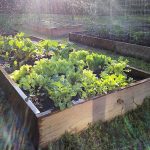If you’re wondering how to get rid of honeysuckle without chemicals – or how to get rid of honeysuckle using only organic methods – you’re not alone. A botanist from the University of Cincinnati asked the same thing. Together with a fellow plants person, he came up with an ingenious solution.
What Is Honeysuckle or Amur Honeysuckle?
Amur honeysuckle (Lonicera maackii) is a species of honeysuckle native to East Asia, particularly China, Korea, and Japan. It is a deciduous shrub that can grow up to 15 feet (4.5 meters) tall and is characterized by its hollow stems and opposite, oval-shaped leaves.
Amur honeysuckle is often cultivated as an ornamental plant for its fragrant, creamy-white flowers, which bloom in late spring to early summer. However, it has become invasive in many parts of North America and Europe, where it was introduced as an ornamental plant. Its aggressive growth habit, rapid spread, and ability to outcompete native vegetation make it a problematic invasive species in these regions.
Due to its invasive nature, efforts are often made to control or eradicate Amur honeysuckle in areas where it threatens native ecosystems.
How to Get Rid of Honeysuckle
Natural Methods for Managing a Honeysuckle Invasion in Your Backyard
The relentless spread of Amur honeysuckle has long been a headache for homeowners and conservationists alike. However, a promising solution is emerging from the University of Cincinnati, where botanist Denis Conover is pioneering eco-friendly techniques to combat this invasive species without resorting to toxic chemicals.
Amur honeysuckle, originally introduced as an ornamental plant over a century ago, has since escaped cultivation, infiltrating natural habitats and outcompeting native vegetation. Its aggressive growth, early budding, prolonged leaf retention, and easy method of spread through seeds carried by birds means it takes over areas quickly and easily.
Conover, in collaboration with Kate Nordyke, former herbarium specialist at Cincinnati’s Spring Grove Cemetery & Arboretum, has been spearheading efforts to control Amur honeysuckle in parks and forests across Cincinnati. Their focus lies on developing sustainable methods for eradication, with a particular emphasis on minimizing environmental impact.
Traditional approaches to honeysuckle removal often involve chainsawing mature plants and applying toxic herbicides to the exposed surfaces. However, Conover’s research has unveiled greener alternatives that are both effective and economical. By experimenting with various materials to block sunlight and deprive the plant of vital nutrients, Conover has devised a simple yet innovative strategy accessible to all homeowners.
Organic Way to Get Rid of Honeysuckle
One organic way to get rid of honeysuckle method involves wrapping the honeysuckle trunk with garden plastic or black garbage bags, effectively cutting off its access to sunlight and causing it to wither over time. This technique, when left in place for approximately 12 weeks, eliminates the need for herbicides while offering a cost-effective and reusable solution.
The process is straightforward: after cutting the bush and any branch shoots low to the ground, the stump and any exposed branch ends are covered with the chosen material and secured tightly. As the honeysuckle succumbs to deprivation, the area can then be replenished with native trees and shrubs, restoring balance to the ecosystem and discouraging future infestations.
Conover emphasizes the importance of native flora in maintaining ecological harmony, highlighting the detrimental impact of invasive species on local biodiversity. By adopting these natural methods of honeysuckle control, homeowners can play a vital role in preserving the health and vitality of their backyard ecosystems.
As concerns over environmental sustainability continue to grow, Conover’s work offers a beacon of hope, demonstrating that effective pest management can be achieved without compromising on ecological integrity. With a little ingenuity and a commitment to green practices, the battle against invasive species like Amur honeysuckle can be won, one backyard at a time.
The source for this article is a press release shared by the University of Cincinnati which has been rewritten.




